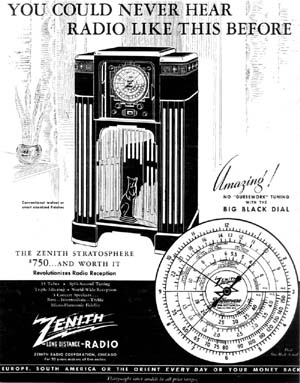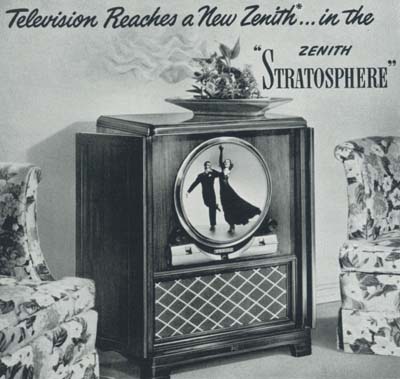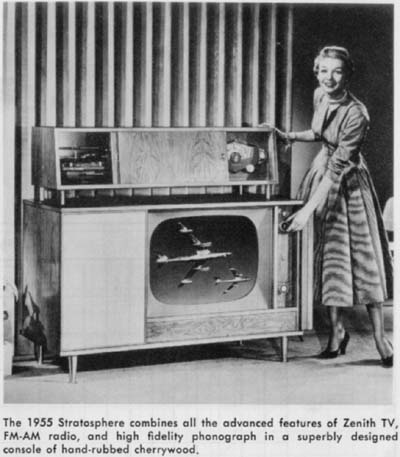Zenith soars to the Stratosphere
From the very beginning, Zenith focused on high quality radios, even if they were more expensive than
the competition. In fact, their slogan in the 1920s was "It Costs More, but it Does More". Even so, Zenith
did make radios available to everyone by having a range of lower priced models along with the higher priced
ones. Zenith strived to keep their name known for quality. In much later years, Zenith's slogan was "The Quality
Goes In Before The Name Goes On". Except for the decade of the 1990s, this was a well deserved slogan.
For 1926, Zenith introduced a series of very expensive radios called the Deluxe models. They ranged in price
from $650 to $2000! These radios were very well designed 10 tube battery sets with a single dial control.
These big fancy radios were re-introduced in the 1927 line as AC operated sets topping out at $2500 for the
"Spanish Deluxe" model. King Alexander I of Jugoslavia astounded his court officials with his Spanish Deluxe
Zenith.
For 1928, Zenith introduced automatic tuning after buying patents from Harry N. Marvin. They included this feature
in higher end models until 1934 when the new "airplane" style dial made the mecahanics extremely difficult to employ
the automatic mechanism.
The top of the line models introduced for 1928 were the 37A, 39A and the exquisite 40A which cost $850.
By 1931, Zenith was licensed to manufacture the Superheterodyne circuit which until then, was monopolized by RCA.
For 1932, They introduced several "Superhets" with the top of the line being the 10 tube models 91 and 92 and the
14 tube model 103. These were exceptional radios with performance unheard of in previous models!
1933 was a time of heavy experimentation for Zenith as they tried to find their niche in the depths of the depression.
They managed to stay afloat and actually turn a profit due to the excellent management of Commander Eugene McDonald
(president) and Hugh Robertson (Treasurer). In fact, if it wasn't for these two men, Zenith would not have been the success
story that it is.
For 1933, Zenith's top of the line radios were the 12 tube 430, 440, 441, 442, 444 and 619. All used the same chassis
and two 12 inch Jensen speakers making them very well performing radios.
December 1934, Zenith introduced the 25 tube Stratosphere model 1000Z. This radio was the most impressive and best performing of any
Zenith radio to date! It still holds its own as probably the best Zenith radio ever made! Zenith engineers pulled out
all the stops for this beauty. They used every advancement possible in technology available in 1933-34 they could find.
The tubes used were the recently introduced 6.3 volt filament types. The speakers used were Jensen's recently introduced
A-12 Concert Dynamic 12" Woofers (Two of them) and a Jensen dynamic exponential horn tweeter. It was one of the first radios to
have a 50 watt power amplifier and elaborate crossover network for the speakers. The cabinet was exquisitely made with rare
woods and designed by artist and industrial designer Frank I. Johnson of Rockford, Ill. The Dial assembly was very unique
with 6 layers of glass, one for each band and one in front with the Zenith Stratosphere logo. This radio was the introduction
of the famous "Big Black Dial" that was Zenith's hallmark for the next decade or so. This dial was patented by Commander
McDonald himself. The 1000Z Stratosphere sold for $750
 The ad that appeared in LIFE magazine December 1934
The ad that appeared in LIFE magazine December 1934
Evidently, the radio wasn't perfect, so after the first run of 100 Stratospheres, Zenith released a revised circuit design.
Minor changes were made, mostly in the RF amplifier section and First Audio circuit. Zenith co-founder Karl Hassel was called
in to help Zenith engineers with audio problems in the Stratosphere. The revised circuit was the result of these efforts.
Although, considered a 1935 model, Zenith kept the 1000Z Stratosphere in the Zenith catalogs and brochures through 1938.
For the 1936 model year, Zenith introduced two more Stratosphere models. These were the 16 tube Stratospheres models 16-A-61
and 16-A-63. They were very impressive radios, but not quite as well designed as their big brother the 1000Z. Zenith also
introduced the model 12-A-58 which many collectors call the "Baby Stratosphere". Zenith never appointed the Stratosphere name to
this model, but it shared many traits in cabinet design as well in dial design to the 1000Z.
By 1938, the two 16 tube Stratospheres were discontinued, and Zenith introduced several 15 tube models to their line. The 1000Z
was still listed in the catalogs.
Zenith had 15 tube models from 1938 through 1940, but 1941 was unusual. The top-of-the-line had only 12 tubes. Although, it had
a 15" speaker, it did not have a tweeter or even a tuning indicator. There is evidence to suggest that Zenith had a 15 tube FM model in the works,
but it was never produced.
For the 1942 model year, Zenith came back with a WHOPPER! Two Whoppers to be exact! The Arlington model 22-H-698 and Concord model
22-H-699 were 22 tube models with two chassis and 3 speakers very much like the 1000Z Stratosphere!
These radios had the recently introduced Armstrong FM band and were Bi-Amplified with four 6A3 tubes driving the two 12" Woofers
and a pair of 6A3 tubes driving a 6" cone tweeter! This was the first radio Zenith made that could compare to the 1000Z Sratosphere.
Unfortunately, they did not have a chrome plated chassis or a cabinet design of rare woods. The RF circuitry was not as advanced
for the AM band but focused on high performance of the FM band. Incidently, these radios only have one Shortwave band.
About 1948-49, Zenith offered a Television with the name Stratosphere. Although television was new at the time, it didn't have the
Top-Of-The-Line stigma the radios offered. It did, however have a rather large screen when other brands has much smaller screens.

In 1955, Zenith introduced another Stratosphere. This time it was a B&W Television, radio and phonograph combination. This set
was influenced with the design styles of the 1950s with a very moderne plain-jane cabinet. It did sport Zeniths "Space Command"
remote control which was new at the time.

In all, there were 4 seperate radios (if you consider the 1000Z revised a seperate radio) and two televisions to bear the name "Stratosphere".
As far as I know, Zenith never used the name again after 1955.
By 1982, Zenith had dropped out of the radio buisness alltogether and focused on Televisions, VCRs and Computers. They sold the
computer division in 1989 and by 1999, they were absorbed by LG (Lucky Goldstar) Electronics of Korea. There is nothing left of Zenith
anymore except the name which is still owned by LG Electronics.
Home
 The ad that appeared in LIFE magazine December 1934
The ad that appeared in LIFE magazine December 1934
